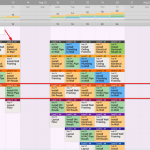There are three truths about the current state of data center construction projects: business is booming, a lot of money is riding on them, and deadlines are fast and furious.
While this is exciting news for owners and contractors, the expectations — and pressure — have never been higher. Delays in data center construction can cost owners millions, which creates a narrower margin of error for contractors.
One of the best ways to ensure data center construction projects run as smoothly as possible is by implementing the Last Planner System® (LPS). Let’s look at LPS and its application to data center construction projects.
Last Planner System: An Overview
When you consider the many collaborators in a data center construction project, it’s easy to see how schedule and time misalignment can emerge without a proven method for project planning.
Since its initial development in the 1990s, LPS has given contractors of large projects a roadmap that, as the Lean Construction Institute states, “promotes the creation of a predictable workflow among various parties so that it achieves reliable results.”
LPS brings all relevant stakeholders together during five different components of the construction process: master scheduling, phase scheduling, look-ahead planning, commitment planning, and learning. Through the LPS method, decisions go from broad and long-term to more immediate and granular as the project progresses, with applied learnings throughout.
The key to success is ensuring all stakeholders are sharing relevant data in real-time and all others are keeping up with those inputs to inform the next steps.
For more context, we’ll explore those five LPS components and how they apply to data center construction projects.
Perfecting Data Center Construction Scheduling
Master scheduling and phase scheduling are in the “things we should do” category of LPS, representing everything stakeholders hope to accomplish during the project.
Master Scheduling
A running joke about master schedules is that it’s wrong the second you send it. Numerous constraints throw even the best data center construction project off track, but a master schedule isn’t intended to be a crystal ball. Instead, the 30,000-foot view of the project sets the tone by identifying the high-level milestones and goals that will define future phases of work and potential overlaps, which can delay completion.
Communication among all the invested parties is paramount when creating a master schedule. Gather stakeholders — owners, designers, general contractors, and MEP contractors — to share their project visions as soon as it’s practical. Then, work together to determine the best combination of those visions.
The final master schedule will require a great deal of compromise, but LPS is based on the foundation of continuous communication. Working collaboratively throughout the project becomes second nature when a culture of dialogue is established early.
Phase Scheduling
Once milestones have been established, phase scheduling can begin. This period is highlighted by sequencing out 6-12 week periods via pull planning: collaboratively defining and sequencing the tasks by working backward from milestones established in the master schedule.
This is also where those responsible for doing the work are brought into the discussion, and the goal of the planning sessions is to identify all of the tasks necessary to complete each milestone. It’s also critical in phase scheduling to establish the conditions of satisfaction for the handoffs between the tasks.
In data center projects, for example, phase scheduling helps prevent crew stacking and ensures general contractors and MEPs have the space they need to do their jobs safely and efficiently.
This is also the time when decision-makers need to address procurement of supplies and equipment. Given the unique nature of data center infrastructure components, e.g., power, cooling, etc., putting in extra legwork in phase scheduling can help reduce the risk of supply chain instability once work begins.
Last Planner System Addresses Tactical Needs
After master and phase scheduling conclude, the “boots-on-the-ground” portion of the project begins. Look-ahead planning and commitment planning focus specifically on plans of action and addressing variances.
Look-Ahead Planning
This is where last planners enter the “things we can do” phase of the project — what can be accomplished based on the information at hand. Last planners are no longer dealing with theoreticals, but instead focusing on identifying constraints that could impact deadlines over the next 4-6 weeks of work.
Typically, a weekly meeting is held to review work and review variance reports to identify any emerging constraints that can be addressed before they disrupt deadlines. Each constraint is assigned to a team member who will lead the charge in finding solutions to the constraint or initiating a workaround.
For example, if the shipment of a power system component is delayed, the last planners determine how to address the delay and what work can be done instead of installing that component. With this new direction, they’ll have to determine how to procure teams to do the newly scheduled work and determine the ripple effect of that change.
Adhering to look-ahead planning principles gives last planners the one advantage they need most: the time to course correct and prevent minor delays from becoming costly stoppages.
Commitment Planning
As the project moves further down the timeline, last planners identify “things we will do.” Commitment planning (also referred to as weekly work planning) is hyper-focused on making good on promises. With a commitment to collaboration and accurate data sharing in the first three phases, commitment planning becomes much easier to manage.
This is also when last planners send requests for information (RFI) to owners and other parties to weigh in on emerging issues. While owners are more than willing to invest a lot of money into a data center construction project, they’re less enthusiastic about delays that impede the return on that investment. As such, commitment planning is necessary to ensure stated deadlines are met, and progress is communicated to owners on a timely basis.
Typically, project teams have commitment planning meetings once weekly to go through the week’s work and implement minor adjustments as necessary. This is a good opportunity to address any safety concerns, crew allocation, and any other topic that could prevent teams from meeting commitments. The end result is a vast reduction of last-minute surprises. This is followed by daily huddle sessions to ensure the week’s plan remains on track.
Acquiring and Applying Historical Knowledge
Learning
Every project has a learning curve, and last planners are responsible for gleaning what went well and what went wrong, and applying that insight to future iterations. This is the “things we did” phase, where last planners rely on percent plan complete (PPC) reports to identify the percentage of weekly promises met and variance reason reports (VRR) that identify the reasons they fell short of commitments. Analyzing those variances are an integral part of mitigation plans and keeping operations on track.
To be clear, learning should occur throughout the project: the master plan, phase schedule look-ahead planning and commitment planning.
To continuously improve, teams must regularly take inventory of what went well (plusses) and what didn’t (deltas) with the previous week’s plan. We often see the most dramatic impact in learning is from the construction of one building to the next in a large data center campus project.
The PPC baseline is often at 50-60% in the first building construction. By the second, the plan will be refined. After that, the plan should resemble a template, with adjustments for constraints in later stages.
As data center construction projects become larger and more complex, contractors understand the need to run the tightest ship possible. The Last Planner System can provide the organization, communication, and collaboration infrastructure necessary to keep projects moving forward.
Learn how Touchplan helps to support the Last Planner System and gives decision-makers the accurate insight they need to keep data center construction plans on time and under budget.





